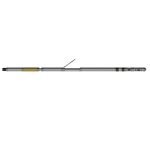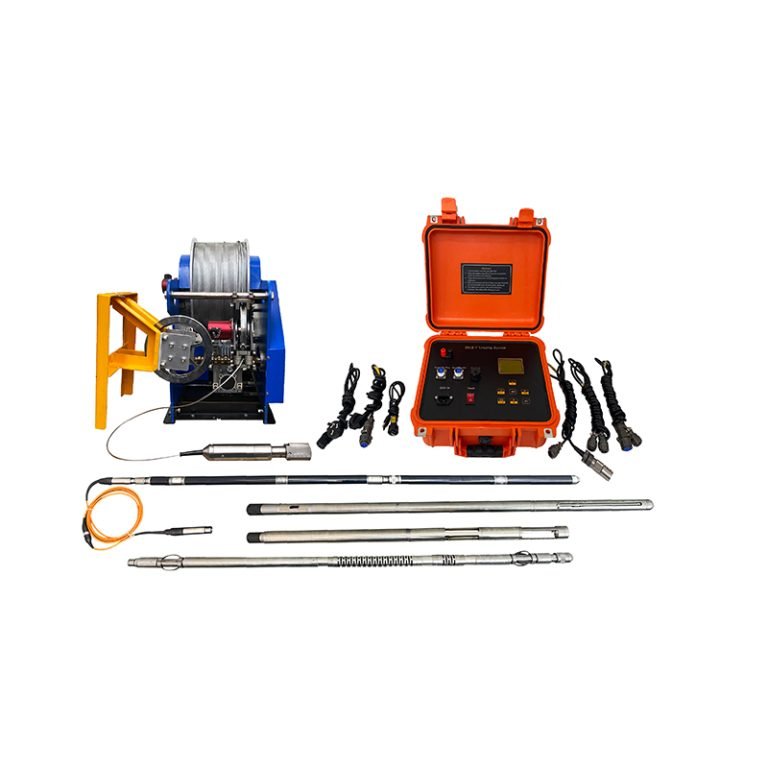Welcome to Geotech!

JMTC Probe
PRODUCT PARAMETERS
- The motor retracts and extends the wellbore diameter and monitors the entire retraction and extension process, which is safe and reliable.
- The downhole instrument structure has been optimized, the operation is simple, the seismic resistance of the instrument has been greatly improved, and it is more durable
- Multiple parameters are measured simultaneously, greatly improving work efficiency.
Description
JMTC Cement Quality & Multi-Information Comprehensive
 Abstract
Abstract
JMTC Cement Quality & Multi-Information Comprehensive is a multi-purpose, high-efficiency combined logging tool. It can simultaneously measure multiple parameters such as casing cement damping, well temperature, top angle, azimuth, natural gamma, and monopolar current in one trip. The sensor that measures the energy attenuation rate of ultrasonic pulses is used to evaluate the cement quality of casing and formation, and is suitable for use in well construction with casings of various materials.

 Applicable Conditions
Applicable Conditions
● Cased
● Bare hole fill with water or mud
 Applications
Applications
● When constructing wells with casing made of various materials,the cement return height position and the bonding quality between the casing and the formation are detected
● Hydrology and groundwater resources survey
● Earthquake imminent and early prediction research, geological disaster prevention and control engineering
 Features
Features
● The motor retracts and extends the wellbore diameter and monitors the entire retraction and extension process, which is safe and reliable.
● The downhole instrument structure has been optimized, the operation is simple, the seismic resistance of the instrument has been greatly improved, and it is more durable
● Multiple parameters are measured simultaneously, greatly improving work efficiency.
 Specifications
Specifications
| Cementation index measurement range | 0~100% |
| Well temperature measurement range | 0℃~85℃;Resolution: 0.025℃ |
| Well inclination (top angle) measurement range | 0°~30°; Measurement accuracy: ±0.1° |
| Azimuth measurement range | 0°~360° (geomagnetic azimuth);Accuracy: Better than ±4° (vertex angle 1°~30°) |
| Natural gamma sensor | Nal crystal + photomultiplier tube |
| Natural gamma counting range | 0~65000CPS;Energy threshold: >0.06MeV |
| Underground power supply electrode | Φ50x50mm |
| Current measurement range | 0~5500μA |
| Hole bottom pressure measurement range | 0~10MPa; Accuracy: 0.001MPa |
| Applicable aperture | 60~300mm |
| Signal output | Bipolar encoding |
FAQ
① In SI, it is m·s-2, and one percent of it is the international unit abbreviation g.u.;
② Conversion between SI and CGS: 1g.u.=10-1 mGal
Gravitational field: The space around the earth with gravity is called the gravitational field.
Gravitational potential: The gravitational potential W in the gravitational field is equal to the work done by a particle of unit mass moving from infinity to that point.
① The normal gravity field of the earth: Assuming that the earth is a rotating ellipsoid (reference plane), the surface is glossy, the internal density is uniform, or it is distributed in concentric layers, the density of each layer is uniform, and the deviation of the shape of the ellipsoid from the geoid is very small, then the gravity field generated by the earth is the normal gravity field.
② The normal gravity value is only related to the latitude, the smallest at the equator and the largest at the poles, with a difference of about 50,000 g.u.; the rate of change of the normal gravity value with latitude is the largest at 45° latitude, and zero at the equator and the poles; the normal gravity value decreases with increasing altitude, and its rate of change is -3.086 g.u.. The main feature of the long-term change is the "westward drift" of the geomagnetic elements, both the dipole field and the non-dipole field drift westward, and have a global nature.
The gravitational field strength is equal to the gravitational acceleration in both numerical and dimensional terms, and the two are in the same direction. In gravity exploration, all references to gravity refer to gravitational acceleration. The gravitational field strength at a point in space is equal to the gravitational acceleration at that point.
Gravity exploration is an exploration method that is based on the density difference of rocks and ores. Since density difference will cause local changes in the normal gravity field of the earth (i.e. gravity anomaly), it is used to solve geological problems by observing and studying gravity anomalies.
-1.png)








